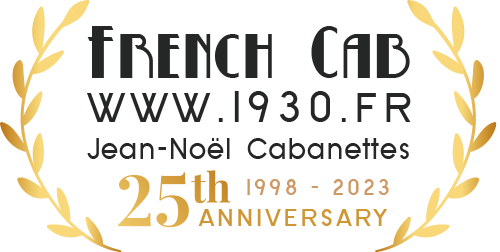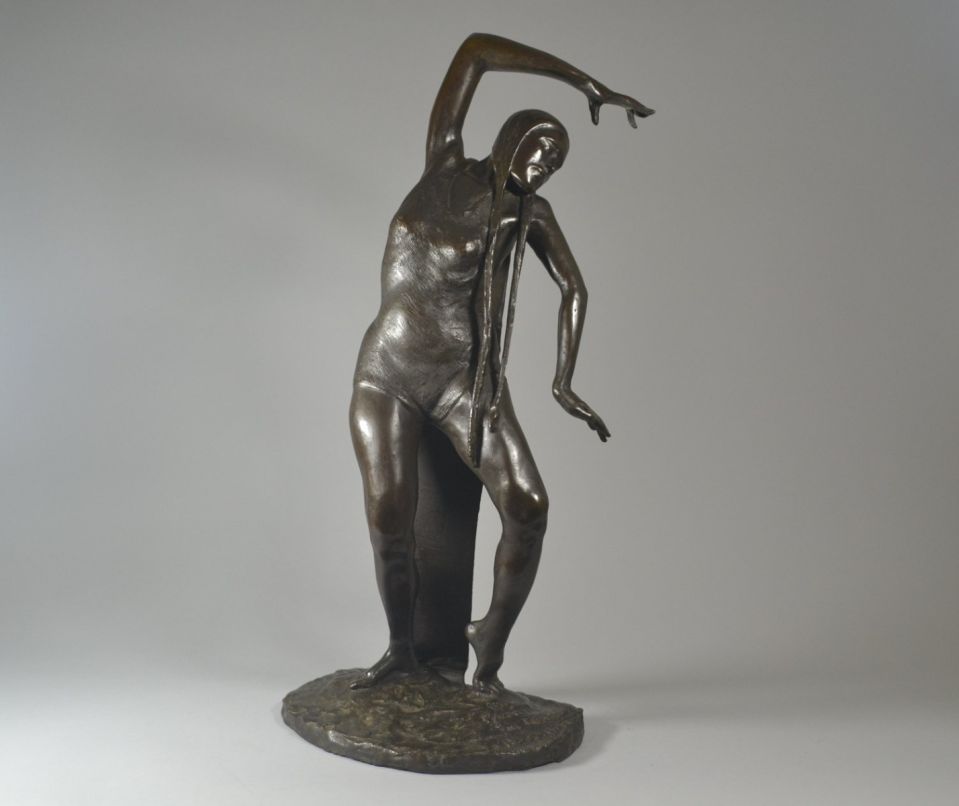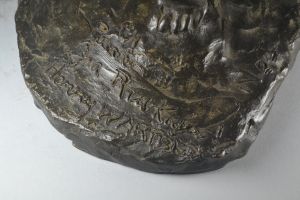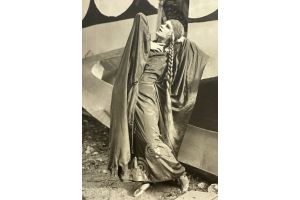Jia Ruskaja iconic dancer. Unique bronze by Baron Wartberg
Herbert Von Ledermann Wartberg (1900-????)
Jia Ruskaia
Patinated bronze sculpture. Signed. Dedicaced to Jia Riskaya. Numbered "N°1"
Probably unique.
German / Italian. Circa 1925. Excellent condition and patina.
58cm hihg.
We are proud to offer you here a bronze sculpture of great historical and artistic importance.
This is a portrait of the famous Russian dancer, who settled in Italy in the early 1920s, created by the German sculptor Baron Herbert Von Ledermann Wartberg.
If the dancer and choreographer Ruskaja is very famous and the subject of numerous publications, the sculptor Wartberg has left us little information on his work and his existence.
We did a lot of library research and were finally able to establish that Wartberg, a member of high society in the 1920s, often traveled throughout Europe. He was the heir of a rich family.
He was a student of the very famous sculptor Antoine BOURDELLE. He notably stayed in Italy in the 1920s where he met the dancer, autographed her and undoubtedly offered the sculpture that we are now presenting. (We find the mention of this sculpture in an exhibition which took place in Rome in 2023 and whose subject was the artistic representations of the Ruskaja Dancer. At this stage I have not contacted the organizers of the exhibition to find out more).
In several French newspaper articles from the 1920s we find Wartberg exhibiting his sculptures, notably in Paris at the Colette gallery.
More anecdotally, he is also famous for having painted women's legs by imitating the sewing of stockings, a practice which became common during the period of the Second World War when women faced a shortage of stockings.
Finally we find his trace when he was interned in the Nazi camp of Mechelen (Mechelen) where he drew portraits and works that tended towards surrealism.
Jia Ruskaja
With her father, an officer in the Russian Imperial Army, Ruskaja fled Russia in 1918 just after the October Revolution. She studied dance in Crimea, before attending medical school in Geneva. Ruskaja married Evans Daniel Pole in Constantinople in 1920; after their marriage was annulled, their son lived in London with his father. Her dancing debut occurred 4 June 1921 in Rome at the Casa d'Arte Bragaglia. She opened her first ballet school in Milan at the Teatro Dal Verme in 1929. From 1932 to 1934, she directed the La Scala Theatre Ballet School. After her marriage to Aldo Borelli, editor of Corriere della Sera, Ruskaja received Italian citizenship. In 1940, she founded the Royal School of Dance, initially attached to the Accademia Nazionale di Arte Drammatica Silvio D'Amico, which became independent in 1948 as Accademia nazionale di danza, a school which only admitted women. She was its director until 1970. Daisy Parrilla and Eleonora Abbagnato had contentious claims to the “Premio Roma Jia Russkaja” prize in 2011.
Jia Ruskaia
Patinated bronze sculpture. Signed. Dedicaced to Jia Riskaya. Numbered "N°1"
Probably unique.
German / Italian. Circa 1925. Excellent condition and patina.
58cm hihg.
We are proud to offer you here a bronze sculpture of great historical and artistic importance.
This is a portrait of the famous Russian dancer, who settled in Italy in the early 1920s, created by the German sculptor Baron Herbert Von Ledermann Wartberg.
If the dancer and choreographer Ruskaja is very famous and the subject of numerous publications, the sculptor Wartberg has left us little information on his work and his existence.
We did a lot of library research and were finally able to establish that Wartberg, a member of high society in the 1920s, often traveled throughout Europe. He was the heir of a rich family.
He was a student of the very famous sculptor Antoine BOURDELLE. He notably stayed in Italy in the 1920s where he met the dancer, autographed her and undoubtedly offered the sculpture that we are now presenting. (We find the mention of this sculpture in an exhibition which took place in Rome in 2023 and whose subject was the artistic representations of the Ruskaja Dancer. At this stage I have not contacted the organizers of the exhibition to find out more).
In several French newspaper articles from the 1920s we find Wartberg exhibiting his sculptures, notably in Paris at the Colette gallery.
More anecdotally, he is also famous for having painted women's legs by imitating the sewing of stockings, a practice which became common during the period of the Second World War when women faced a shortage of stockings.
Finally we find his trace when he was interned in the Nazi camp of Mechelen (Mechelen) where he drew portraits and works that tended towards surrealism.
Jia Ruskaja
With her father, an officer in the Russian Imperial Army, Ruskaja fled Russia in 1918 just after the October Revolution. She studied dance in Crimea, before attending medical school in Geneva. Ruskaja married Evans Daniel Pole in Constantinople in 1920; after their marriage was annulled, their son lived in London with his father. Her dancing debut occurred 4 June 1921 in Rome at the Casa d'Arte Bragaglia. She opened her first ballet school in Milan at the Teatro Dal Verme in 1929. From 1932 to 1934, she directed the La Scala Theatre Ballet School. After her marriage to Aldo Borelli, editor of Corriere della Sera, Ruskaja received Italian citizenship. In 1940, she founded the Royal School of Dance, initially attached to the Accademia Nazionale di Arte Drammatica Silvio D'Amico, which became independent in 1948 as Accademia nazionale di danza, a school which only admitted women. She was its director until 1970. Daisy Parrilla and Eleonora Abbagnato had contentious claims to the “Premio Roma Jia Russkaja” prize in 2011.
REFERENCE: ji2510




















